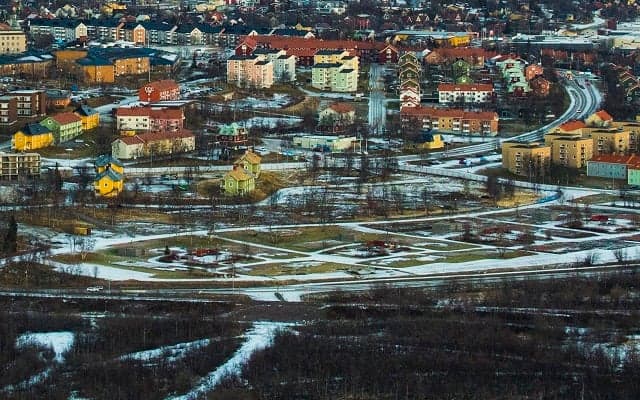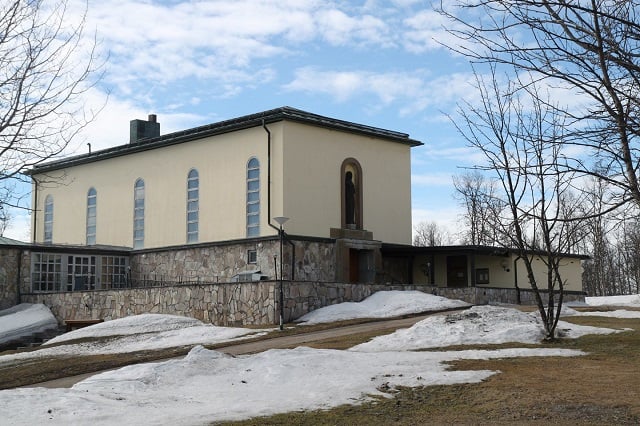When you move an entire city, what happens to its dead?

Kiruna, Sweden's most northerly town, is being relocated eastwards building by building in order to ensure its survival. But when you move an entire town, what happens to the remains of its dead?
So far, some of the oldest and most important buildings in Kiruna have already been carefully moved to new locations so that mining company LKAB – the region's major employer – can continue expanding underground.
Soon it will be the turn of thousands of urns housed in the Mariakapell church to move, while the church itself is to be demolished and knocked down.
Around 3,000 people's remains are currently kept in the church's columbarium, creating not just a logistical challenge but an ethical one too, and LKAB has been in close contact with the church about how to carry out the relocation.
Before any urns can be moved, the Swedish Church has the task of identifying them and contacting around 2,500 burial rights holders whose details aren't in the church's records. A burial rights holder is the person who has the right to decide what happens to the urn and its contents, and so they need to be informed about the planned move.
"We have the columbarium at the Mariakapell, and that will be torn down during the town's move, so we need to get in touch with all the burial rights holders so we can start moving the urns, for example, and we've already started doing that," Tommy Stridsman, Kiruna parish head of property, told The Local. "The urns are around ninety years old, the oldest of them."
"Mariakapell will be torn down in around ten or 12 years maybe – the town is moving, so we also have to move to a new place, and we have to prepare for that," he explained.

Mariakapellet in Kiruna. Photo: LKAB
READ ALSO: Five great reasons to move to northern Sweden
In order to track down the relatives of the deceased, the parish has put announcements in local and national newspapers as well as sharing posts on social media asking relatives of those buried in the columbarium to get in touch with the church.
But Stridsman said he believed it would be possible to find most of the affected families well before the move, saying: "We'll be able to find most of the burial rights holders, but if not, [the rights] are returned to the parish. We will make sure that the urns are taken to a new place, to a memorial spot or a new columbarium."
"Today, a huge of number of people have rung," he said. "There's a lot of interest and there will be even more interest the closer the move gets. I'd say that almost all of them have been positive. You need to have a good dialogue with the burial rights holders. This is something that moves people, and we understand that, but we think it will go well."
Stridsman explained that there were no graves at the site, and only one gravestone: that of the founder of Kiruna, Hjalmar Lundbohm, the one person buried at Kiruna Church. Stridsman said this grave would "definitely also be moved in the future".
READ MORE:
-
IN PICTURES: The Swedish mining town that's being moved 3km
-
Moving Swedish town starts demolition mission
-
Stunning memory park for moved Swedish town
As of now, there was no fixed plan for how the move would be carried out. Stridsman explained: "It's a few years away, and I'm sure we will come up with a good method for the move. It might be that there's a ceremony when it comes to the move.
Anders Lindberg from LKAB confirmed this, and said "work is ongoing to come up with possible solutions and the parish has also started the search for relatives to [those whose remains are within the] urns."
"It is one of our most important relocation projects since it requires special reflection and consideration," Lindberg told The Local. "We started the project a year ago together with the parish, which was seven years ahead of the planned move."
Buildings of cultural and historical importance are being moved, but others are being knocked down, and demolition began in 2015. Over the 20-year project, a total of 3,000 schools, homes, and businesses are expected to be destroyed.
Hundreds of the town's 18,000 residents have already moved to the newly built part of town.
The first buildings to go were among the newest – apartment blocks commissioned by mining firm LKAB for its workers in the 1960s – but some of those scheduled for demolition are over a century old.
But the relocation of the town's churches has been one of the most delicate questions. While Mariakapell will be knocked town, Kiruna's main church is scheduled to be moved in its entirety in the mid-2020s. Kiruna Church was built in 1909, a gift from LKAB to the town and one of Sweden's iconic buildings, formed in the shape of a Sami tent.
READ ALSO:
Comments
See Also
So far, some of the oldest and most important buildings in Kiruna have already been carefully moved to new locations so that mining company LKAB – the region's major employer – can continue expanding underground.
Soon it will be the turn of thousands of urns housed in the Mariakapell church to move, while the church itself is to be demolished and knocked down.
Around 3,000 people's remains are currently kept in the church's columbarium, creating not just a logistical challenge but an ethical one too, and LKAB has been in close contact with the church about how to carry out the relocation.
Before any urns can be moved, the Swedish Church has the task of identifying them and contacting around 2,500 burial rights holders whose details aren't in the church's records. A burial rights holder is the person who has the right to decide what happens to the urn and its contents, and so they need to be informed about the planned move.
"We have the columbarium at the Mariakapell, and that will be torn down during the town's move, so we need to get in touch with all the burial rights holders so we can start moving the urns, for example, and we've already started doing that," Tommy Stridsman, Kiruna parish head of property, told The Local. "The urns are around ninety years old, the oldest of them."
"Mariakapell will be torn down in around ten or 12 years maybe – the town is moving, so we also have to move to a new place, and we have to prepare for that," he explained.

Mariakapellet in Kiruna. Photo: LKAB
READ ALSO: Five great reasons to move to northern Sweden
In order to track down the relatives of the deceased, the parish has put announcements in local and national newspapers as well as sharing posts on social media asking relatives of those buried in the columbarium to get in touch with the church.
But Stridsman said he believed it would be possible to find most of the affected families well before the move, saying: "We'll be able to find most of the burial rights holders, but if not, [the rights] are returned to the parish. We will make sure that the urns are taken to a new place, to a memorial spot or a new columbarium."
"Today, a huge of number of people have rung," he said. "There's a lot of interest and there will be even more interest the closer the move gets. I'd say that almost all of them have been positive. You need to have a good dialogue with the burial rights holders. This is something that moves people, and we understand that, but we think it will go well."
Stridsman explained that there were no graves at the site, and only one gravestone: that of the founder of Kiruna, Hjalmar Lundbohm, the one person buried at Kiruna Church. Stridsman said this grave would "definitely also be moved in the future".
READ MORE:
- IN PICTURES: The Swedish mining town that's being moved 3km
- Moving Swedish town starts demolition mission
- Stunning memory park for moved Swedish town
As of now, there was no fixed plan for how the move would be carried out. Stridsman explained: "It's a few years away, and I'm sure we will come up with a good method for the move. It might be that there's a ceremony when it comes to the move.
Anders Lindberg from LKAB confirmed this, and said "work is ongoing to come up with possible solutions and the parish has also started the search for relatives to [those whose remains are within the] urns."
"It is one of our most important relocation projects since it requires special reflection and consideration," Lindberg told The Local. "We started the project a year ago together with the parish, which was seven years ahead of the planned move."
Buildings of cultural and historical importance are being moved, but others are being knocked down, and demolition began in 2015. Over the 20-year project, a total of 3,000 schools, homes, and businesses are expected to be destroyed.
Hundreds of the town's 18,000 residents have already moved to the newly built part of town.
The first buildings to go were among the newest – apartment blocks commissioned by mining firm LKAB for its workers in the 1960s – but some of those scheduled for demolition are over a century old.
But the relocation of the town's churches has been one of the most delicate questions. While Mariakapell will be knocked town, Kiruna's main church is scheduled to be moved in its entirety in the mid-2020s. Kiruna Church was built in 1909, a gift from LKAB to the town and one of Sweden's iconic buildings, formed in the shape of a Sami tent.
READ ALSO:
Join the conversation in our comments section below. Share your own views and experience and if you have a question or suggestion for our journalists then email us at [email protected].
Please keep comments civil, constructive and on topic – and make sure to read our terms of use before getting involved.
Please log in here to leave a comment.